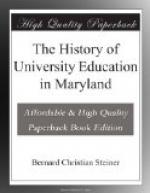As early as January 3, 1785, only two weeks after the College was decided on, its managers were able to report that L1,057 had been subscribed, a sum that put the enterprise on a firm footing. The site was next to be chosen, and Abingdon in Harford County was pitched upon. Of the 15,000 Methodists in the Union in 1784, over one-third were in Maryland, and hence, it had the best claim for the College, and the beauty of the situation of Abingdon charmed Coke so much that he determined upon placing the College there. It was also a place easy of access, being on the direct stage line from Baltimore to Philadelphia and near the Chesapeake Bay. Bishop Coke, the most zealous advocate of the College, contracted for the building materials; but was prevented from being present at the laying of the corner-stone. Bishop Asbury, however, was present and preached a sermon on Psalms 78, verses 4 to 8.[29] In this sermon, “he dwelt on the importance of a thoroughly religious education, and looked forward to the effects, which would result to the generality, to come from the streams which should spring from this opening fountain of sanctified learning.” The building was built of brick, one hundred feet in length and forty in width, faced east and west, and stood on “the summit and centre of six acres of land, with an equal proportion of ground on each side.” It was said to be in architecture “fully equal, if not superior, to anything of the kind in the country.” Dormitory accommodations were provided in the building; but it was intended that “as many of the students as possible, shall be lodged and boarded in the town of Abingdon among our pious friends,"[30] Gardening, working in wood in a building called the “Taberna Lignaria,” bathing under supervision of a master, walking, and riding were the only outdoor exercises permitted. The students were prohibited “from indulging in anything which the world calls play. Let this rule be observed with the strictest nicety; for those who play when they are young, will play when they are old.”
In 1785 the Bishops issued a “Plan for Erecting a College intended to advance Religion in America.” It is quite long and many of its provisions are very quaint. From it we learn that Cokesbury is intended “to receive for education and board the sons of the elders and preachers of the Methodist Episcopal Church, poor orphans, and the sons of the subscribers and other friends. It will be expected that all our friends, who send their children to the college, will, if they be able, pay a moderate sum for their education and board; the others will be taught and boarded and, if our finances allow it, clothed gratis. The institution is also intended for the benefit of our young men, who are called to preach, that they may receive a measure of that improvement, which is highly expedient as a preparation for public service.” Teachers of ancient languages and of English will be provided, and no necessary branch of literature




